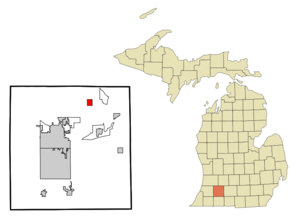- Richland, Michigan
Infobox Settlement
official_name = Richland, Michigan
settlement_type = Village
nickname =
motto =
imagesize =
image_caption =
image_
imagesize =
image_caption =
image_
mapsize = 250px
map_caption = Location of Richland, Michigan
mapsize1 =
map_caption1 =subdivision_type = Country
subdivision_name =United States
subdivision_type1 = State
subdivision_name1 =Michigan
subdivision_type2 = County
subdivision_name2 = Kalamazoogovernment_footnotes =
government_type =
leader_title =
leader_name =
leader_title1 =
leader_name1 =
established_title =
established_date =area_footnotes =
area_magnitude =
area_total_km2 = 3.1
area_land_km2 = 3.1
area_water_km2 = 0.0
area_total_sq_mi = 1.2
area_land_sq_mi = 1.2
area_water_sq_mi = 0.0population_as_of = 2000
population_footnotes =
population_total = 593
population_density_km2 = 190.9
population_density_sq_mi = 494.4timezone = Eastern (EST)
utc_offset = -5
timezone_DST = EDT
utc_offset_DST = -4
elevation_footnotes =
elevation_m = 283
elevation_ft = 928
latd = 42 |latm = 22 |lats = 35 |latNS = N
longd = 85 |longm = 27 |longs = 20 |longEW = Wpostal_code_type =
ZIP code
postal_code = 49083
area_code = 269
blank_name = FIPS code
blank_info = 26-68240GR|2
blank1_name = GNIS feature ID
blank1_info = 0635881GR|3
website =
footnotes =Richland is a village in Kalamazoo County in the
U.S. state ofMichigan . The population was 593 at the 2000 census.The village is within Richland Township about nine miles northeast of Kalamazoo.
Geography
According to the
United States Census Bureau , the village has a total area of 1.2square mile s (3.1km² ), all land.Demographics
As of the
census GR|2 of 2000, there were 593 people, 258 households, and 170 families residing in the village. Thepopulation density was 494.4 per square mile (190.8/km²). There were 301 housing units at an average density of 251.0/sq mi (96.8/km²). The racial makeup of the village was 96.29% White, 0.17% African American, 0.17% Native American, 1.35% Asian, 0.17% from other races, and 1.85% from two or more races. Hispanic or Latino of any race were 1.52% of the population.There were 258 households out of which 29.5% had children under the age of 18 living with them, 54.7% were married couples living together, 8.1% had a female householder with no husband present, and 34.1% were non-families. 29.5% of all households were made up of individuals and 14.3% had someone living alone who was 65 years of age or older. The average household size was 2.30 and the average family size was 2.84.
In the village the population was spread out with 24.6% under the age of 18, 5.1% from 18 to 24, 26.8% from 25 to 44, 26.3% from 45 to 64, and 17.2% who were 65 years of age or older. The median age was 43 years. For every 100 females there were 80.2 males. For every 100 females age 18 and over, there were 78.1 males.
The median income for a household in the village was $50,938, and the median income for a family was $58,542. Males had a median income of $42,250 versus $30,956 for females. The
per capita income for the village was $23,777. About 1.2% of families and 1.4% of the population were below thepoverty line , including none of those under age 18 and 7.5% of those age 65 or over.History
Richland is located in the middle of what was once the Gull Prairie, an upland area relatively free of trees and maintained by natural and man-made fires. The area had a few
Pottawatamie villages, one was located on the west side of nearby Gull Lake. Fish and game were plentiful, and the land was very fertile. Since there were few trees to clear, the prairie was among the first areas ofKalamazoo County to be settled. By the 1830s, the Native Americans had been moved west, and Richland was a thriving frontier village. The village even contended with Prairie Ronde for the county seat, but the centrally-located village of Bronson (nowKalamazoo ) was ultimately chosen.Lacking a flowing stream that would have provided water power, Richland never developed significant industry and remained a sleepy farm community until the late twentieth century. In the 1980s and 90s, small employers such as Richard Allen Medical moved to the edge of town, and Richland became a bedroom community for Kalamazoo. The high quality of the local Gull Lake School District also drew people from surrounding areas. New subdivisions were built in what had been hilly farm country.
High Schools
References
Wikimedia Foundation. 2010.


